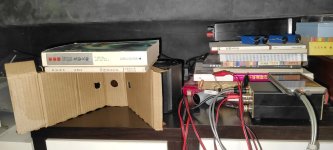This might be a silly question, but I've been wondering if there are any tips for listening to parts of a multi-way speaker individually?
I've been working on some multi-entry horn ideas, but want to test out various parts individually to get a feel for how they sound before commiting to a complete build around certain drivers.
It got me thinking of using an existing speaker and just EQing out the range of interest and then using it to "accompany" the driver in question.
Please let me know if anyone has ideas about this.
I've been working on some multi-entry horn ideas, but want to test out various parts individually to get a feel for how they sound before commiting to a complete build around certain drivers.
It got me thinking of using an existing speaker and just EQing out the range of interest and then using it to "accompany" the driver in question.
Please let me know if anyone has ideas about this.
The crossover region isn't likely to sound right on it's own. Properly blending the other part of the cross can make the strangeness disappear, but doing a crossover properly is likely to be too difficult for creating a makeshift support. I'd still try both ways, just keep an open mind as you do.
For something like this, I typically use an active variable crossover (or two), equalizer, and another finished speaker. With those elements, you can usually dial into a balanced, usable blending of the new and old speakers pretty quickly. Of course it requires extra amp channels as well.
The frequency response of the cone drivers when coupled to the multiple entry horn is so radically different to their response individually that there would be little to learn listening to them that way.I've been working on some multi-entry horn ideas, but want to test out various parts individually to get a feel for how they sound before commiting to a complete build around certain drivers.
Thanks... that was along the lines of what I was thinking.For something like this, I typically use an active variable crossover (or two), equalizer, and another finished speaker. With those elements, you can usually dial into a balanced, usable blending of the new and old speakers pretty quickly. Of course it requires extra amp channels as well.
weltersys: Makes sense! I just want to go step by step and know if the results are even in the right solar system. 🙂
I've been thinking about this too. A pair (or quad) of bookshelf speakers placed / \ with boards (or thick Al-foil-backed car anti-vibration pads) for the horn sides. Just got a used pair of HF108 to play with next long weekend.
Last edited:
I think so, the 3khz hump is nicely shaped. But it's past midnight here and I had spent maybe an hour on it using scrounged bits. After tweaking the horn angle in real-time (!), I was quite surprised it worked so well. Besides being extremely dynamic, it rendered superlative transcients and performance detail I hadn't heard before. Alas mono. I think I can notch out 2.7-3.5khz passively and move the high-pass much lower; but not necessarily better.
I was really thinking active/EQ/etc but Minimalism strikes again!
(correction: 2.2uF not 0.22)
I was really thinking active/EQ/etc but Minimalism strikes again!
(correction: 2.2uF not 0.22)
Attachments
Last edited:
I posted a follow-up to the Fullrange Photo Gallery:
For some time now I've wanted to compare my reflector-coaxial PrimeRadiant against another quasi-coherent-point-source 2-way, the Multi-Entry-Horn. I can't really do the MEH justice, but here's a Minimalist MEH (Minmei) experiment done over three sessions, listening and tweaking the passive filters to tame back flat the horn-bloat FR -- a rather fool-hardy challenge. But it has been fun and the result extremely vivid, detailed, and dynamic -- if not "holographically deep" like my coherent speakers or a really good fullrange driver. I did more-or-less time-align the drivers but phase would...
- Home
- Loudspeakers
- Multi-Way
- Listening to Parts of a Multi-way Build

